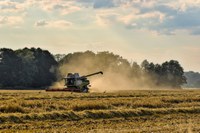Prairie Fare: Meals in the field, past and present
(Click an image below to view a high-resolution image that can be downloaded)
A few years ago, I ordered DNA testing kits for me and my husband. I do not think he was thrilled with his Christmas gift.
He teased me when our results came back showing he had a more purebred bloodline than I have. His ancestors were primarily of German ancestry, and I am of Scandinavian, mainly Norwegian, descent. Somehow our “mixed marriage” has worked more than 30 years.
Later, my results were updated showing that I am more Norwegian than he is German. Now it was my turn to tease him.
Every now and then I receive a new “leaf” to add to my digital family tree on the company’s platform. One of my distant cousins must be a genealogist. After connecting with her family tree recently, I traced my heritage back to the early 1700s in Norway, when life must have been a matter of survival.
My U.S. roots go back to my great-grandfather who bought a ticket on a ship to America in about 1869. He had a trunk containing all his possessions. He was a farmer at heart and by name, because our shared last name meant “rural farm” in Norwegian. As I look at his portrait, which is now in my home, I can see he was a small, wiry man who had a long, bushy beard.
Like other early farmers across the country, he cleared acres of land with horses and plows and grew fields of wheat. The early settlers established stores and churches that dotted the countryside to form small towns.
These early immigrants were self-sufficient and had all the basics of a healthful diet covered. They had chickens and cows for a regular fresh supply of eggs and milk. They grew gardens, hunted, fished and raised animals for meat and milk. They preserved meat by using salty brines, smoking and drying to survive the cold months on the northern Plains.
Many people still do all of these activities, or at least some of them. However, we have many other options to get food on our tables.
Earlier generations cooked over fireplaces, which also provided heat in the homes. According to historic records, dinner was often a big meal in the center of the day. The basics of cooking were passed down from mothers to daughters, and cookbooks did not become popular in U.S. homes until after World War II.
In early days, everything was “cooked from scratch” since frozen and packaged foods were not invented. Without electricity, they had no refrigerators, freezers or any appliances.
Our ancestors couldn’t search an app on a phone for a recipe. They couldn’t order pizza delivery either.
Coolers for food storage and water bottles for regular hydration were not invented, nor were air-conditioned tractor cabs.
Times have changed from those early agrarian efforts. They managed to survive many challenges leading to our presence today. We all need nourishment, even when we are working in different ways from our ancestors.
Our modern-day agriculture workers continue to toil to provide food for the world, but in more efficient ways.
Recently, I was asked to create a “meals in the field” program for North Dakota Extension agents to use. It includes a pocket guide handout with eight recipes and lots of tips, so I will share a few ideas.
Regardless of how we spend our days, we need balanced meals to fuel our bodies and minds. Planning healthful meals takes a little time but pays off.
Be sure to include a protein source such as dairy, meat, poultry and/or a plant source such as beans, lentils and nuts. Adding vegetables, fruits and whole grains to menus provides healthful carbohydrates along with vitamins, minerals and fiber.
When food is transported, take care to keep perishable food hot or cold depending on the food. When using a cooler, remember that blocks of ice are more efficient at keep food cold. Fill Thermos containers with boiling water and then empty before adding hot soup or beverages.
Be sure to have a way to keep your hands clean, such as using moist towelettes followed by a hand sanitizer with 60% alcohol to kill germs.
Consider wrapping hot sandwiches with plastic wrap and then foil to help them maintain their temperature during transport.
Visit www.ag.ndsu.edu/food and go to the “Food Preparation” section of the website then go to “Now You’re Cookin’” for a series of handouts with numerous recipes and tips, along with the new “Pocket Guide to Meals in the Field.” Here’s one of the recipes.
Beef and Bean Burritos
½ pound ground beef
2 (15 to 16 oz.) cans kidney, pinto or red beans
1 onion, chopped
1 tablespoon chili powder or 1 package taco seasoning
8 large flour tortillas
Salsa of choice
Chop onion. Brown ground beef and onion in a frying pan. Drain fat. Mix in kidney beans and chili powder. Put a spoonful of meat mixture in the center of the tortilla. Fold opposite edges of the tortilla over the meat. Then fold both ends to the center so you form a pocket. Set burrito in baking dish. Heat burritos in a covered dish for 10 to 15 minutes at 350 degrees Fahrenheit. Serve with salsa. Wrap in plastic wrap then tin foil for an easy grab and go meal/snack. Some potential side items include whole-grain tortilla chips, carrot sticks and watermelon chunks.
Makes eight servings. Each serving has, 400 calories, 8 grams (g) fat, 21 g protein, 61 g carbohydrate, 7 g fiber and 790 milligrams sodium.
(Julie Garden-Robinson, Ph.D., R.D., L.R.D., is a North Dakota State University Extension food and nutrition specialist and professor in the Department of Health, Nutrition and Exercise Sciences. Follow her on Twitter @jgardenrobinson)
NDSU Agriculture Communication – Sept. 7, 2023
Source: Julie Garden-Robinson, 701-231-7187, julie.garden-robinson@ndsu.edu
Editor: Elizabeth Cronin, 701-231-7881, elizabeth.cronin@ndsu.edu




